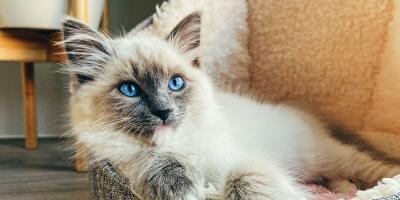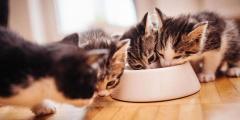
Kittenhood is a playful, adorable time in a cat’s life. It is also a time for a high-energy diet that meets the demands of her growing and developing body. Read on to learn how much to feed a kitten, what food to feed her and how often she should be eating.
What Should I Feed My Kitten?
Cats less than one year of age are considered kittens. During this time, they need a food that is formulated with the nutrients necessary for healthy growth and development. The kibble in Purina’s kitten food is smaller in size than adult kibble, which makes it easier for your kitten to eat, but it also provides more calories for energy. It is also formulated with an enhanced nutritional profile that provides your kitten with the complete and balanced diet she needs.
Some of those nutrients include:
- More calories, protein and fat than adult foods to keep up with the demands of their growing bodies.
- The omega fatty acid DHA, which is an important nutrient for brain and vision development in kittens.
- Vitamins and minerals, including vitamin E and selenium, are beneficial antioxidants that aid the developing immune systems in kittens.
- Kittens also need optimal calcium to phosphorus ratio for proper bone growth.
How Much Should I Feed My Kitten?
Generally, kittens start to nibble on solid food at three to four weeks of age. After eight weeks of age, you can start feeding kittens dry or moistened food. The best place to start when figuring out how much to feed a kitten is to look at the recommended feeding instructions on her food. Always make sure to use measuring cups to give your kitten equal and accurate portions and always take into account age and weight when figuring out how much to feed her.
How Often Will My Kitten Eat?
We recommend that you begin offering moistened dry food at three to four weeks old. Moistening your kitten’s food makes it easier for them to chew and swallow. During this time, it is best to split the recommended daily amount of food into several servings throughout the day.
Make sure to only moisten one of these servings at a time, rather than preparing the entire daily amount at once and leaving it out all day for grazing. Smaller, moistened servings throughout the day will keep the food fresh and encourage your kitten to eat.
When moistening your kitten’s food, make sure to add no more than one part water to three parts dry food and use warm (not hot) water.
Important Things to Remember
- The total daily amount of food required to help maintain your kitten's ideal body condition will vary depending on age, activity and environment. Monitor your kitten's weight and adjust the food amount accordingly.
- Always provide fresh water in a clean container each day and try to monitor the water intake to make sure your kitten is properly hydrated. To learn more, read our article on cat hydration.
- Be sure to follow the Feeding Instructions and our Recommended Daily Feeding Amounts on the packaging.
Related articles



